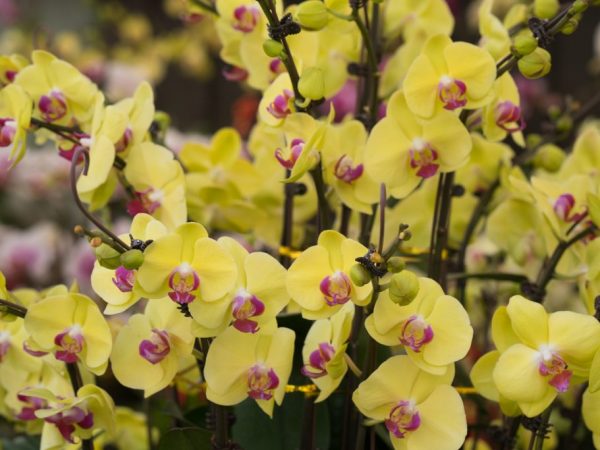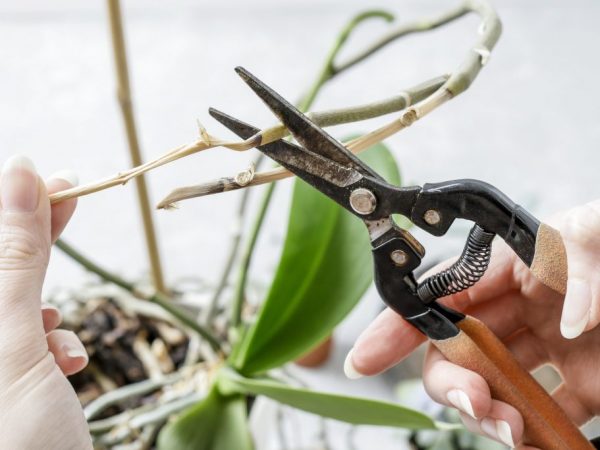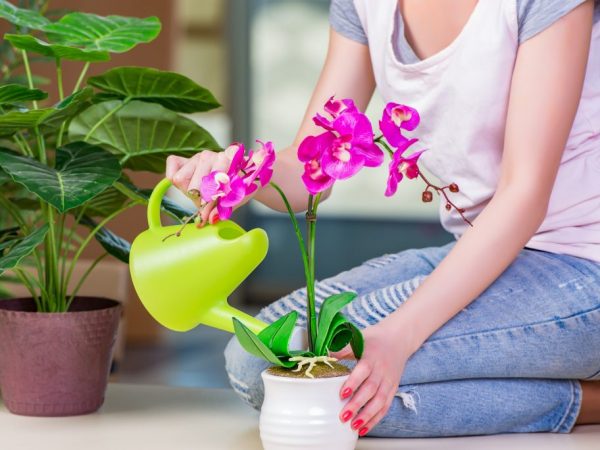Orchid restoration
Florists, engaged in the cultivation of decorative and exotic plants, know that the restoration of an orchid is a laborious process. To save the plant, determine what factors cause the disease.

Orchid restoration
Causes of wilting orchids
Orchid wilting is of two types:
- Natural. In this case, the plant is simply going through a period of rest and renewal. With natural regeneration of the bush, only the lower leaves are subject to wilting. You do not need to tear them off. They will disappear on their own as soon as they give all their nutrients to the stem. The natural dying off of part of the leaves is provided by nature and no action is required to reanimate the orchid.
- Painful. This wilting occurs when the plant experiences stress and discomfort. This type of wilting is characterized by a general painful appearance of the entire bush, pallor and weakness of all leaves and a change in the color of the stem (it loses brightness and elasticity).
Painful wilting can be caused by:
- violations of the temperature regime (overheating, hypothermia);
- violations of irrigation rules (mode and volume);
- incorrect feeding or the wrong choice of drugs;
- transplantation violations;
- stem damage.
A systematic violation of even one of the rules of care will lead to the fact that it will be impossible to save the orchid.

Orchid wilting can be natural or painful
Temperature violation
- Temperature too low (plant freezes).
- The temperature is too hot (the plant is dehydrated).
The orchid is frozen
The homeland of the orchid is the tropics, that is, a warm, humid environment, and therefore sometimes it is necessary to reanimate an orchid that is frozen from the cold air from the air conditioner. If slippery dark spots appear on the leaves (with a characteristic slug bloom), this means that you need to immediately reanimate the orchid, the flower is on the verge of death.
To reanimate an orchid that has frozen, it must be immediately limited from the cold and changed from regular watering to watering and spraying with warm water. The second step it will take to save a home orchid is to rid the dead crop of damaged leaves. Reanimation of the orchid makes sense only if the spots cover 1-2 leaves. If all the leaves are damaged, there is no point in fighting the problem. It is almost impossible to revive an orchid without leaves.
Cutting off frozen sheets
For the cutting operation, you will need a sharp blade treated with 70% alcohol solution. The spots are cut directly from the sheet. The cut site (wound) is sprinkled with activated carbon powder. If the entire sheet is damaged, it must be cut lengthwise and gently holding the pieces of the plate with two fingers, pull the plate out of the stem sinus.
If the orchid is not very frozen and has undergone the operation of trimming the leaves without much loss, the restoration of the bush is observed after 2-3 days. After the operation, the plant is sprayed with Epin's solution diluted according to the instructions for a week, once a day, this will help save the orchid from starvation and restore its strength.

For trimming, you need a sharp blade, treated with an alcohol solution
Orchid got heatstroke
Orchid is a moisture-loving plant. If the temperature in the room is too hot and dry, or if the flower is exposed to the sun for a long time, the culture will receive heatstroke and will also need resuscitation.
If an exotic culture has burned out, you cannot immediately spray the plant, so it will not work to reanimate the phalaenopsis, but will only aggravate the condition of the diseased stem. We transfer the flower to a cooler room, protected from the sun, for example, to the bathroom. Wait until the stem and leaves have cooled (become cool) and only then resuscitate.
- The first step is to humidify the air around the flower - spray water around the bush, being careful not to get moisture on the leaves.
- After two hours, the bud in the pot should be slightly moistened, and after another two hours it is permissible to spray the plant itself.
Heatstroke is no less dangerous than freezing, the plant dies with any violation of the rules of maintenance and care.
Irrigation system disturbance
Watering errors primarily affect the root system of the orchid. But the only correct watering system for a plant like phalaenopsis simply does not exist. Abundant watering provokes root rot, as a result of which the plant dies. Watering too rarely will lead to the fact that the bush will begin to dry out and die as well.
Excess moisture
The fact that the plant suffers from an excess of moisture will be indicated by a gray bloom at the roots of the bush, as well as a moist bloom in the lower region of the stem. If the flower was watered every day and abundantly, this is already a reason to state with confidence the decay of the root and then urgent resuscitation of the orchid at home is required.
It will be difficult to revive an orchid with rotten roots. It is impossible to completely stop watering - as the soil dries out in the pot, the soil is moistened without flooding the bush. Restoring a plant with damaged roots is a long process. If not the entire root system has rotted, there is still a chance to restore it. If, even after resuscitation, the leaves are sluggish, the stem is weak - the plant still dies, it can no longer be restored.
Lack of watering
The fact that the soil inside is drying out or has already dried up will be indicated primarily by the sharp wilting of the leaves. It is impossible to use abundant watering as a means of salvation - this will aggravate the situation. You need to start by spraying the bush. To save an orchid dying and drying up, spraying and watering is done as follows:
- The first spraying should be done so that the plant is not exposed to an intense waterfall of spray. It will be correct to switch the sprayer to the fine spray mode and spray at a distance of 25-30 cm from the bush.
- Watering is required little by little, 1.5 hours after spraying.
The roots dry out first, and the plant will not be able to cope with a large amount of moisture, it will simply choke on it, and the process of death will accelerate.
Improper feeding
Phalaenopsis resuscitation due to improper fertilization of the bush will be needed when:
- Complete lack of feeding.
- The wrong choice of the drug.
- Overfeeding the plant.
Each of the reasons can lead to the death of the plant.

Improper feeding can cause wilting
Complete lack of feeding
This culture is not adapted by nature to grow in different soil conditions. The natural substrate in central Russia does not have the components necessary for such a plant. Therefore, feeding is one of the most important conditions for high-quality care for such an exotic flower.It is impossible to neglect the fertilization of the bush at different periods of growth and development. It is possible to reanimate a weakened phalaenopsis by introducing a biological product.
Wrong drug
Phalaenopsis is a plant that is demanding to care for, and an incorrectly chosen preparation for feeding is often the cause of the death of the bush. For such exotic plants, there are special types of fertilizers on sale.
During the period of intensive growth, the following are used:
- mineral mixtures;
- biohumus;
- growth stimulant.
During the flowering period, the following are used:
- fertimix;
- leaf fertilizer;
- stimulant.
Excess dressing
Overfeeding a plant can rarely cause frequent fertilization; in most cases, novice growers simply make the wrong solutions to support a flowering crop. If you do not adhere to the rules and make too thick a concentrate, the plant will get overfeeding. Overfeeding an exotic flower is called fattening, or poisoning. The fact that the plant has been overfed will be indicated by a change in the color of the leaves and stem - most often the color from green becomes purple or bluish.
It will be possible to neutralize the poisoning only if you notice the changes in time and change the substrate in the pot.
Transplanting a bush in case of poisoning
To revive the plant, it is important to follow the instructions:
- Thoroughly moisten the soil in the pot until it is completely softened so that the plant is pulled out along with the clods of earth.
- Next, the roots are carefully cleaned of the substrate (wash out the ground with a sprayer). Bare roots will show rot from overfeeding.
- The damaged parts of the bush are cut off.
- The cleaned bush is transplanted into a new pot with a clean substrate. The soil needs to be slightly moistened, and the bush itself should be sprayed with warm purified water.
If overfeeding has managed to inflict damage to most of the root, the likelihood that the bush will survive is minimal.
Violation of the transplant rules
If, in the process of transplanting the plant into another pot, the rules were violated, the orchid will die. Phalaenopsis is unlike other plants and is difficult to transplant. The most common mistake that occurs when transplanting is root damage. If a recently transplanted orchid bush withers, it is still possible to save an orchid, but repeated transplantation is also stress, repeated violation of the rules will simply destroy the flower:
- The first step is to thoroughly soak the soil.
- Next, the flower is removed from the pot and transferred to water.
- After a day or two, examination of the root system will reveal broken roots.
- The damaged roots are truncated, and the plant is again placed in water for a day.
- The substrate for the new pot is taken soft, preferably a special soil for orchids.
- Fill the pot by three quarters, carefully place the plant, sprinkle the roots with earth (until completely covered). It is impossible to tamp the soil.
- Moisten the soil using a sprayer.
- Place the transplanted plant in a shaded place.
After transplantation, especially carefully monitor the temperature regime. Any deviation of 2-3 ° C will kill the plant.

If transplanted incorrectly, the orchid may die.
Broken stem
It is possible to save a broken orchid only if at least one stem remains, on which there are 2-3 growth points. If the peduncle and neck are absent, the rescue of such an orchid is not carried out.
For high-quality resuscitation, you will need a cover for the bush. It is necessary to make something out of the package, something like a mini-greenhouse. Installation of such a greenhouse will not be difficult:
- In the soil near the remains of a diseased bush, set three sticks 15-17 cm high in a triangle.
- Next, put a plastic bag over them, pull it down and fasten it around the rim of the pot on the hydrogel.
- It is important that the package rises above the bush by at least 15 cm.
Such greenhouses can also be used if you want to restore a sun-dried crop.
Conclusion
Each cause of the disease of an exotic plant has its own ways of solving. Restoration of the watering regime will help to revive a flooded or dried orchid. If the root system has rotted, but the main root remains, we save the plant by transplanting. To save the decorative phalaenopsis, which was unknowingly poured with top dressing and it dies from fattening, changing the substrate will help. If the flower is broken, but at least one living eye remains, the phalaenopsis will recover and grow back on its own.

